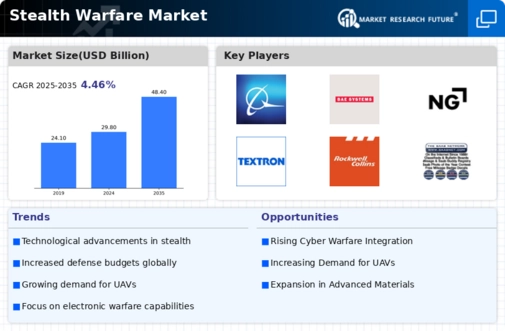Top Industry Leaders in the Stealth Warfare Market

Key Players:
Lockheed Martin Corporation (U.S.)
BAE Systems (U.K)
Northrop Grumman Corporation (U.S.)
Saab AB (Sweden)
Boeing (U.S.)
General Dynamics Corporation (U.S.)
Raytheon Company (U.S.)
Leonardo S.p.A (Italy)
Thales Group (France)
Chengdu Aircraft Corporation (China)
Strategies Adopted:
The key players in the stealth warfare market deploy various strategies to maintain their competitive edge. Research and development (R&D) investments remain paramount, as breakthroughs in materials, propulsion systems, and sensor technologies are crucial for achieving superior stealth. Collaboration and partnerships are common strategies, with companies often forming alliances to combine expertise and resources. Additionally, strategic acquisitions enable companies to broaden their product portfolios and enhance their overall market presence.
Factors for Market Share Analysis:
Several factors contribute to the analysis of market share in the stealth warfare sector. Technological prowess and innovation play a pivotal role, as superior capabilities often translate into a larger market share. The ability to offer integrated solutions, combining stealth with advanced sensors and communication systems, is another critical factor. Global partnerships and collaborations with defense organizations also influence market share, as they provide access to larger contracts and international markets. Timely delivery and effective after-sales support contribute to customer satisfaction, fostering repeat business and market dominance.
New and Emerging Companies:
While established giants dominate the stealth warfare market, a wave of new and emerging companies is making notable strides. Kratos Defense & Security Solutions, a U.S.-based company, has gained recognition for its affordable and high-performance drone systems with stealth features. Turkey's Baykar, known for its Bayraktar TB2 drone, has emerged as a formidable player in the unmanned aerial systems segment. The entry of these companies signals a shifting landscape, challenging traditional players and fostering innovation.
Industry News:
Recent industry developments underscore the dynamic nature of the stealth warfare market. The adoption of artificial intelligence (AI) and machine learning algorithms for stealth platforms is a notable trend, enhancing autonomous decision-making and adaptability in various scenarios. Moreover, advancements in metamaterials, which manipulate light and electromagnetic waves to achieve unprecedented levels of stealth, have garnered significant attention. Industry players are closely monitoring geopolitical events, as shifts in alliances and defense budgets can significantly impact market dynamics.
Current Company Investment Trends:
Investment trends in the stealth warfare market reflect the industry's focus on cutting-edge technologies. Companies are allocating substantial resources to research and development, aiming to stay ahead in the race for superior stealth capabilities. Cybersecurity investments are on the rise, as the integration of digital technologies exposes stealth platforms to new vulnerabilities. Sustainable and eco-friendly technologies are also gaining traction, aligning with global efforts towards greener defense solutions. The emphasis on training and skill development within companies is evident, ensuring a competent workforce capable of navigating the evolving landscape.
Overall Competitive Scenario: The overall competitive scenario in the stealth warfare market is marked by a delicate balance between traditional powerhouses and agile newcomers. While established companies benefit from decades of experience and extensive resources, emerging players bring fresh perspectives and nimble innovation. The race for technological supremacy continues unabated, with each player striving to outpace the others in developing the next generation of stealth platforms. Collaboration and strategic alliances are expected to increase as companies seek synergies to address complex challenges and capitalize on emerging opportunities.
Recent News
Lockheed Martin Corporation (LMT):
F-35 fighter jet: Successfully completed first flights of the Block 4 upgrade, boasting enhanced sensor fusion and cyber security capabilities, keeping the Lightning II at the forefront of aerial infiltration.
Next Generation Air Dominance (NGAD) Program: Unveiled concept art for the successor to the F-35, promising hypersonic speeds, advanced anti-access/area-denial (A2/AD) capabilities, and even drone control, pushing the boundaries of air combat.
Northrop Gruman Corporation (NOC):
B-2 Spirit bomber: Upgraded navigation and targeting systems for the legendary "Ghost", ensuring its dominance in precision strikes for years to come.
B-21 Raider bomber: On track for first flight in 2025, promising next-generation capabilities for penetrating heavily defended airspace and delivering devastating payloads.
Boeing Company (BA):
F/A-18E/F Super Hornet: Integrated new conformal fuel tanks and weapons carriage modifications, extending range and versatility for this multi-role combat aircraft.
MQ-25A Stingray refueling drone: First operational deployment with the U.S. Navy, providing aerial refueling capabilities to extend fighter jet range and strike potential.
Thales Group (HO):
Ground-based radars: Developed next-generation radars with advanced signal processing and counter-stealth capabilities, attempting to pierce the shadows of adversaries.
Active electronically-scanned array (AESA) radars: Integrated onto various platforms, including fri gates and aircraft, offering superior target tracking and discrimination in complex environments.


